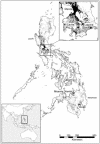Circulation of type 1 vaccine-derived poliovirus in the Philippines in 2001
- PMID: 15564462
- PMCID: PMC533948
- DOI: 10.1128/JVI.78.24.13512-13521.2004
Circulation of type 1 vaccine-derived poliovirus in the Philippines in 2001
Abstract
In 2001, highly evolved type 1 circulating vaccine-derived poliovirus (cVDPV) was isolated from three acute flaccid paralysis patients and one contact from three separate communities in the Philippines. Complete genomic sequencing of these four cVDPV isolates revealed that the capsid region was derived from the Sabin 1 vaccine strain but most of the noncapsid region was derived from an unidentified enterovirus unrelated to the oral poliovirus vaccine (OPV) strains. The sequences of the cVDPV isolates were closely related to each other, and the isolates had a common recombination site. Most of the genetic and biological properties of the cVDPV isolates were indistinguishable from those of wild polioviruses. However, the most recently identified cVDPV isolate from a healthy contact retained the temperature sensitivity and partial attenuation phenotypes. The sequence relationships among the isolates and Sabin 1 suggested that cVDPV originated from an OPV dose given in 1998 to 1999 and that cVDPV circulated along a narrow chain of transmission. Type 1 cVDPV was last detected in the Philippines in September 2001, and population immunity to polio was raised by extensive OPV campaigns in late 2001 and early 2002.
Figures





Similar articles
-
Sabin Vaccine Reversion in the Field: a Comprehensive Analysis of Sabin-Like Poliovirus Isolates in Nigeria.J Virol. 2015 Oct 14;90(1):317-31. doi: 10.1128/JVI.01532-15. Print 2016 Jan 1. J Virol. 2015. PMID: 26468545 Free PMC article.
-
Acute flaccid paralysis associated with circulating vaccine-derived poliovirus--Philippines, 2001.MMWR Morb Mortal Wkly Rep. 2001 Oct 12;50(40):874-5. MMWR Morb Mortal Wkly Rep. 2001. PMID: 11666115
-
Circulating vaccine-derived polioviruses: current state of knowledge.Bull World Health Organ. 2004 Jan;82(1):16-23. Epub 2004 Feb 26. Bull World Health Organ. 2004. PMID: 15106296 Free PMC article. Review.
-
Circulation of endemic type 2 vaccine-derived poliovirus in Egypt from 1983 to 1993.J Virol. 2003 Aug;77(15):8366-77. doi: 10.1128/jvi.77.15.8366-8377.2003. J Virol. 2003. PMID: 12857906 Free PMC article.
-
[Eradication of poliomyelitis and emergence of pathogenic vaccine-derived polioviruses: from Madagascar to Cameroon].Med Sci (Paris). 2013 Nov;29(11):1034-41. doi: 10.1051/medsci/20132911021. Epub 2013 Nov 20. Med Sci (Paris). 2013. PMID: 24280508 Review. French.
Cited by
-
Outbreak Response to Circulating Vaccine-Derived Poliovirus in Three Northern Regions of Ghana, 2019.Biomed Res Int. 2024 Oct 4;2024:5515777. doi: 10.1155/2024/5515777. eCollection 2024. Biomed Res Int. 2024. PMID: 39399343 Free PMC article.
-
Is it time to switch to a formulation other than the live attenuated poliovirus vaccine to prevent poliomyelitis?Front Public Health. 2024 Jan 8;11:1284337. doi: 10.3389/fpubh.2023.1284337. eCollection 2023. Front Public Health. 2024. PMID: 38259741 Free PMC article. Review.
-
Genetic characterization and molecular evolution of type 3 vaccine-derived polioviruses from an immunodeficient patient in China.Virus Res. 2023 Sep;334:199177. doi: 10.1016/j.virusres.2023.199177. Epub 2023 Jul 24. Virus Res. 2023. PMID: 37479187 Free PMC article.
-
The Fight against Poliovirus Is Not Over.Microorganisms. 2023 May 17;11(5):1323. doi: 10.3390/microorganisms11051323. Microorganisms. 2023. PMID: 37317297 Free PMC article. Review.
-
Vaccine Technologies and Platforms for Infectious Diseases: Current Progress, Challenges, and Opportunities.Vaccines (Basel). 2021 Dec 16;9(12):1490. doi: 10.3390/vaccines9121490. Vaccines (Basel). 2021. PMID: 34960236 Free PMC article. Review.
References
-
- Alexander, J. P., Jr., H. E. Gary, Jr., and M. A. Pallansch. 1997. Duration of poliovirus excretion and its implications for acute flaccid paralysis surveillance: a review of the literature. J. Infect. Dis. 175(Suppl. 1):S176-S182. - PubMed
-
- Bellmunt, A., G. May, R. Zell, P. Pring-Akerblom, W. Verhagen, and A. Heim. 1999. Evolution of poliovirus type I during 5.5 years of prolonged internal replication in an immunodeficient patient. Virology 265:178-184. - PubMed
-
- Benyesh-Melnick, M., J. L. Melnick, W. E. Rawls, I. Wimberley, J. Barrera-Oro, E. Ben-Porath, and V. Rennick. 1967. Studies on the immunogenicity, communicability, and genetic stability of oral poliovaccine administered during the winter. Am. J. Epidemiol. 86:112-136. - PubMed
-
- Blomqvist, S., A. L. Bruu, M. Stenvik, and T. Hovi. 2003. Characterization of a recombinant type 3/type 2 poliovirus isolated from a healthy vaccinee and containing a chimeric capsid protein VP1. J. Gen. Virol. 84:573-580. - PubMed
Publication types
MeSH terms
Substances
LinkOut - more resources
Full Text Sources
Other Literature Sources
Medical

